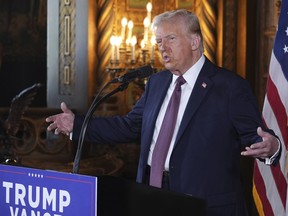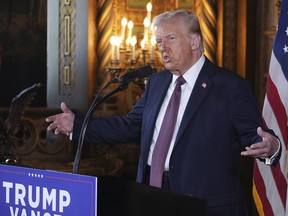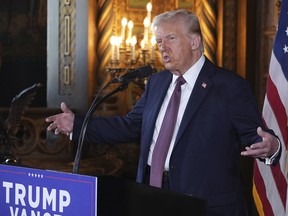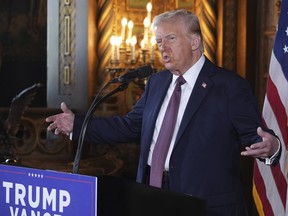A high-stakes clash over North American trading dynamics intensified as Donald Trump, the U.S. president-elect, escalated remarks about making Canada part of the United States. Speaking at his Mar-a-Lago resort in Florida, he again called for substantial tariffs on goods from Canada and Mexico and floated the provocative idea of annexing Canada through what he described as an “economic force” rather than military action. He claimed, in his characteristic blend of bold rhetoric and broad assertions, that removing the artificially drawn border would be beneficial for national security and would redefine the region’s economic landscape. He also asserted that the United States was subsidizing Canada to the tune of roughly US$200 billion annually, tying the assertion to the broader U.S. trade deficit with its northern neighbor.
This evolving brinkmanship sits against a dense backdrop of measurable trade relationships, energy dependencies, and political tremors in both countries. The U.S. has long maintained a robust and deeply integrated economic relationship with Canada, marked by a substantial flow of goods, energy, and other strategic commodities across the border. The proposed tariff trajectory and the notion of expanding the United States’ orbit over a neighboring federation would have sweeping implications for supply chains, policy alignment, and political calculations on both sides of the border. Canada’s response, the state of public opinion, and the internal political dynamics in Ottawa and Ottawa’s partners in the Canadian political spectrum add layers of complexity to what could become a defining moment in cross-border relations.
The current discourse also features substantial data points that anchor the conversation in economic reality. The total U.S. trade deficit in goods and services with Canada stood at US$40.6 billion in 2023, according to official data, a figure that underscores the scale of Canada’s role as a trading partner. Energy trade remains a pivotal axis of this relationship, with the United States importing more than four million barrels of Canadian crude oil each month in certain periods, underscoring Canada’s status as a major energy supplier. These facts interact with broader concerns about market confidence, currency movements, and the resilience of North American supply chains in the face of tariff threats and potential retaliatory moves.
Escalating rhetoric and the core proposals
In a high-profile press conference held at Mar-a-Lago, President-elect Trump sharpened his language about Canada, arguing that the United States should leverage economic measures to redraw the North American economic map. Rather than endorsing a military maneuver, he asserted that “economic force” could, in his view, accomplish what he framed as a strategic realignment. He proposed substantial tariffs on goods from both Canada and Mexico, signaling a muscular, protectionist approach to border economics that would place significant pressure on cross-border trade arrangements. His framing suggested that removing the border’s political and economic demarcations could yield a markedly different national security and economic outcome—an assertion he positioned as mutually beneficial for the United States.
Trump’s remarks also included a striking claim regarding U.S. subsidization of Canada, pegging the figure at roughly US$200 billion annually. While the specifics of such a claim are open to interpretation and warrant careful scrutiny, the assertion fed into a broader argument about leverage, subsidy dynamics, and the perceived imbalance in bilateral trade. The rhetoric thus served two primary purposes: it underscored the perceived leverage of the United States in any future trade arrangement with Canada and invoked a larger narrative about sovereignty, security, and economic autonomy within a deeply integrated continental market.
A central element of Trump’s discourse was the idea that canceling or redrawing the border through “economic force” would reveal a new and potentially superior configuration for North American security and prosperity. The concept hinges on the notion that the border’s artificial demarcation masks a deeper economic reality—the United States and Canada share a comprehensive, interwoven set of industries, supply chains, and strategic resources. Under this framing, the removal or significant reduction of barriers—whether through tariffs or other policy instruments—could produce a scenario in which national interests align more closely, and security concerns are reframed in economic terms.
These points sit within a broader stance on tariffs and trade policy. Trump signaled that tariffs as high as 25 percent could be imposed on Canadian imports, in parallel with similar considerations for Mexico. The prospect of such tariffs would have immediate implications for manufacturing, particularly in sectors like automotive, where the continental supply chain is highly integrated. The call for tariffs reflects a broader strategic aim: to recalibrate the terms of trade, encourage domestic production, and reshape sourcing patterns to align more closely with U.S. policy objectives and domestic industrial priorities.
The rhetoric also touched on Canada’s lumber industry and the notion of executive actions to loosen restrictions on lumber, suggesting potential domestic supply expansion in the United States. In this formulation, executive instruments could be deployed to reorient timber procurement in favor of domestic production, further intensifying the debate over cross-border resource allocation and long-term planning for housing, construction, and manufacturing sectors reliant on lumber imports.
In tandem with these policy signals, Trump’s remarks leaned on the broader argument that Canada’s economic and strategic footprint should be reassessed within the framework of U.S. national security and economic planning. By reframing the bilateral relationship in terms of leverage, tariffs, and potential territorial rearrangements, the discourse sought to shift public and political focus toward a reimagining of regional governance. The implications of such a shift would extend beyond immediate tariff calculations, potentially affecting investment, migration, and the regulatory alignment that underpins cross-border commerce.
The trade-deficit context and energy ties
The discussion of tariffs and annexation sits atop a concrete, data-driven backdrop. The U.S. trade deficit with Canada—measured in 2023 at US$40.6 billion for goods and services—reflects a robust level of bilateral trade activity, even as the two economies are deeply interdependent. The energy relationship in particular anchors much of the bilateral dynamic: Canada is a major supplier of crude oil to the United States, with demand for Canadian crude periodically exceeding four million barrels per day in certain months. This energy link is a defining feature of the continental economy, shaping policy considerations, energy security planning, and even currency movements.
From a macroeconomic perspective, these figures illustrate how a tariff or policy shift could ripple across multiple sectors. Tariffs on Canadian goods would not simply alter the price of a handful of consumer items; they would affect manufacturing costs, supply chain reliability, and investment decisions across industries with complex, cross-border inputs. The energy sector’s sensitivity to policy crosswinds would be particularly pronounced, given the U.S. reliance on Canadian crude and the broader push to secure reliable energy supplies at predictable costs.
Ottawa’s policy responses have already begun to align with the reality of a potential tariff-era. Officials have reportedly studied export taxes on strategic commodities—uranium, oil, and potash—as possible retaliatory tools should tariff tensions escalate into a full-blown trade dispute. While such actions would be calibrated to deter or counter tariff pressure, they would also influence the pricing and availability of critical inputs for U.S. consumers and industries. In this sense, the Canada-U.S. policy dynamic is not a one-sided negotiation; it is a complex, reciprocal calculus in which both sides weigh market signals, production capabilities, and political risk.
The currency dimension reinforces the real-world impact of these policy conversations. The Canadian dollar has shown sensitivity to tariff announcements and protectionist rhetoric, with movements against the U.S. dollar reflecting shifting market expectations. For instance, the loonie’s value weakened slightly in response to tariff threats, illustrating how exchange-rate movements can amplify or cushion the effects of policy shifts. In this specific instance, the loonie traded down by about 0.1 percent to roughly 1.4344 Canadian dollars per U.S. dollar at a given time, highlighting the immediate market reaction to the policy discourse.
Amid these macroeconomic dynamics, the political leadership in Canada faced a consequential test. Prime Minister Justin Trudeau’s public statements emphasized steadfast resistance to changes that would undermine Canada’s sovereignty within the broader continental framework. Trudeau’s social media response underscored a commitment to standing firm against threats, signaling that Canada would not back down in the face of coercive economic pressure. Polls indicated that a wide majority of Canadians—more than eight in ten—opposed the idea of Canada becoming part of the United States, a sentiment that frames the direction of domestic politics and the likely response to external pressure.
Meanwhile, Trudeau’s government had previously sought to manage expectations and reduce political risk by treating the remarks as a joke within certain circles, signaling a political calculus intended to preserve stability and consensus. The official stance of the Canadian government toward the “51st state” rhetoric thus sits at the intersection of public opinion, cross-border diplomacy, and electoral strategy. The domestic political environment—characterized by leadership dynamics, party competition, and the upcoming electoral cycle—shapes how Canada would respond to heightened tariff threats and any proposals regarding policy pivots that would alter the bilateral balance of power.
Canadian political responses and leadership dynamics
In the wake of Trump’s provocative remarks, Canadian leaders and policymakers moved to reinforce a posture of resilience and unity in the face of external pressure. A prominent public signal came from Prime Minister Trudeau, who reiterates that Canada would not concede to any scenario that undermines its sovereignty. His message—delivered through social media and public communications—emphasized that there is no possibility of Canada becoming part of the United States, a statement intended to deter speculation and to reassure Canadian citizens and international partners.
Public sentiment inside Canada appeared robustly opposed to the notion of joining the United States as a state. Polling suggested that more than 80 percent of Canadians rejected the idea, a political reality that would influence the calculus of any government negotiating strategy in the event of sustained tariff threats or aggressive economic pressure. The political leadership thus faces a challenge: to navigate a scenario in which exterior pressures could trigger shifts in policy, industrial strategy, and cross-border cooperation without compromising Canada’s national identity and constitutional boundaries.
Within Canada’s federal structures, there was a clear delineation between the rhetoric of the bilateral negotiation and the practical governance of policy. Trudeau’s government had previously framed the 51st state dialogue as a joking or off-script comment, signaling caution and a preference for maintaining the status quo of the bilateral relationship. Yet, the underlying realities—economic interdependence, shared security concerns, and a mutual interest in stable energy and resource flows—required a measured, policy-driven response that would preserve both economic security and political legitimacy.
On the opposition side, Conservative Party leader Pierre Poilievre emerged as a prominent voice within the Canadian political landscape. Published reporting suggested that Poilievre would be the odds-on favorite to win the forthcoming election, and his stance—articulated as a firm resistance to any notion of Canada becoming a U.S. state—matched public sentiment and reinforced the political impetus for a steadfast posture against coercive economic measures. The dynamic between Trudeau’s governing Liberal Party and the Conservative challenger shaped the policy debates surrounding cross-border trade, energy policy, and national security. It also influenced how Canada would pursue diplomacy with the United States in a landscape where tariff threats and strategic redrawing of economic ties loomed large.
In this context, Canadian leadership faced a dual imperative: to safeguard sovereignty and to sustain the country’s prominent role in the North American economic framework. The government’s approach would have to account for the potential spillover effects of tariff policies on key industries, including energy, manufacturing, and agriculture, and to safeguard the interests of workers and communities reliant on cross-border commerce. The leadership’s response also had to address the risk that aggressive rhetoric could sow uncertainty, potentially affecting investment, job security, and the long-term trajectory of Canada’s industrial base.
The domestic political calculus extended beyond party lines to include voices from the public and civil society. The government’s responses, the messaging around national sovereignty, and the explicit rejection of annexation by the Canadian state contribute to a broader narrative about national identity and strategic autonomy. The interplay of public opinion, party leadership, and cross-border diplomacy will continue to shape Canada’s stance as tariff proposals evolve and as both governments navigate the consequences of a highly integrated yet fragile economic relationship.
Economic policy options and potential retaliation
Ottawa’s contemplation of export taxes on strategic commodities signals a deliberate, policy-driven approach to counterbalance tariff pressure. In a scenario where tariffs on Canadian goods become a reality, policymakers would have to weigh the benefits of protective measures against the long-term costs of reduced access to the U.S. market and the potential retaliation that could follow. Export taxes on items such as uranium, oil, and potash could act as a countermeasure designed to offset some of the economic impact of U.S. tariff policy, but they would also risk triggering a broader escalation of trade tensions and complicating Canada’s relationships with other trading partners.
The energy sector’s central role means any retaliation policy would need to consider the consequences for North American energy security, market stability, and consumer prices. A targeted export tax could influence global energy pricing dynamics, alter investment incentives, and affect the profitability of key Canadian energy producers. It would also pose a challenge to joint energy initiatives and cross-border energy projects that have historically underpinned the U.S.-Canada energy relationship. The policy debate would need to balance the deterrent effect of export taxes with the overall objective of maintaining stable energy flows to the United States, which remains a critical partner.
From the U.S. side, the prospect of 25 percent tariffs on Canadian and Mexican goods would necessitate careful policy design to minimize disruption and avoid a total collapse of cross-border supply chains. The automotive sector stands out as a primary case study, given the deeply integrated manufacturing networks that span both countries. Tariffs of this magnitude could drive up production costs, disrupt just-in-time manufacturing schedules, and accelerate diversification of sourcing in search of lower-cost suppliers or alternative routes. Policymakers would need to weigh the short-term costs against long-term strategic aims, including pushing for domestic investment, reshoring of certain production capabilities, and reinforcement of strategic stockpiles.
Beyond tariffs and potential export taxes, the policy toolbox would likely include currency considerations, investment incentives, and regulatory coordination. Exchange-rate dynamics, already sensitive to tariff discourse, could be influenced by policy signals, potentially magnifying or dampening the effective cost of cross-border trade. Investment incentives in certain sectors—such as energy, manufacturing, and technology—could alter the longer-term industrial map, directing capital toward domestic or regionally integrated projects that align with national strategic priorities.
The broader economic landscape—characterized by global supply chains, the volatility of commodity prices, and the evolving geopolitical environment—would interact with any unilateral or cooperative tariff strategy. A portion of the policy approach would involve building resilience within North American supply chains, exploring diversification of suppliers, and reinforcing cross-border collaboration on critical goods. The ultimate objective would be to manage risk, protect high-value industries, and maintain the economic stability necessary for ongoing domestic growth, even as trade policies are renegotiated or recalibrated.
Market reactions, currency dynamics, and policy signaling
The currency markets and financial instruments would respond to a sustained tariff regime with heightened volatility and risk-pricing. The Canadian dollar’s reaction to tariff threats—reflected in modest declines against the U.S. dollar following announcements of potential tariffs—illustrates the sensitivity of currency markets to cross-border policy developments. Such movements could amplify the cost of imports and the price of exported goods, influencing inflation expectations, consumer spending, and monetary policy discourse in both countries. In this context, currency strength or weakness becomes an additional channel through which tariff policy affects real economies, complicating the policy calculus for central banks and fiscal authorities.
On the energy front, investors would closely monitor how tariff dynamics influence energy trade flows and pricing. The U.S. reliance on Canadian crude oil means that any disruption to the cross-border supply chain could have immediate repercussions for energy markets, refining margins, and consumer energy costs. Market participants would assess the probability of policy stability, the likely duration of tariff regimes, and the potential for policy reversals or negotiated settlements. In this environment, the energy sector’s capital expenditure decisions, exploration programs, and production planning would be sensitive to the policy horizon and the expected trajectory of cross-border trade.
The macroeconomic implications would extend to trade balances, inflation, and growth projections. If tariffs were to become entrenched, the United States might see shifts in the composition of imports, as firms pivot to alternative suppliers or invest in domestic production capacity to mitigate tariff exposure. Conversely, Canada could respond with countermeasures that aim to preserve export volumes to the United States, potentially at the expense of domestic price levels or investment across other sectors. The net effect would be a reconfiguration of the North American economic landscape, with winners and losers across different industries and regions.
In parallel with these dynamics, public governance and political signaling would shape expectations. The Canadian leadership’s insistence on sovereignty and refusal to contemplate a state-based future for Canada would be reinforced by political messaging aimed at maintaining national autonomy and economic resilience. The United States would need to balance its strategic ambitions with the realities of a deeply integrated economy and the political costs of escalating trade tensions. The interplay of market expectations, policy commitments, and diplomatic messaging would thus be central to how this episode unfolds.
Regional and strategic implications
Beyond bilateral considerations, these developments would reverberate across North American regional dynamics and global trade architecture. A shift in the Canada-U.S. trade paradigm would influence not only the two countries but also neighboring economies and trading partners who rely on a stable and predictable North American market. The potential for export taxes and tariff-based measures could alter Canada’s relationships with other key importers and exporters, prompting recalibrations in trade policy, diversification strategies, and regional economic alignments.
The strategic implications would also extend to security cooperation and defense alignment. The idea of reconfiguring the continental economy through tariff-driven convergence or divergence has bearings for shared defense planning, immigration and border policy, and cross-border infrastructure projects. In a region where security considerations are increasingly intertwined with economic resilience, policymakers would need to manage the dual objectives of safeguarding national interests and maintaining stable partnerships with neighboring economies that have long served as anchors of regional prosperity.
At a broader level, the episode tests the resilience of the rules-based trading order. It underscores the ongoing debate about the balance between economic sovereignty and economic integration in a globalized economy. The discussions illuminate the challenges of managing interdependence in a landscape where political rhetoric can quickly morph into policy proposals with tangible consequences for households, workers, and communities on both sides of the border. The outcome would help shape how policymakers think about future steps in negotiating trade arrangements, cross-border collaboration, and the pursuit of shared economic security within the North American region.
Public sentiment, leadership, and electoral considerations
The trajectory of cross-border policy discussions is inseparable from domestic political dynamics in both countries. In Canada, polling indicated broad opposition to the notion of Canada becoming part of the United States, a sentiment that provides political space for leaders to resist coercive economic pressure without sacrificing public support. The leadership context—especially in light of Trudeau’s government and the anticipated electoral contest—will shape the tone and substance of Canada’s response to tariff threats. The political calculus includes considerations of party leadership, policy priorities, and public messaging about sovereignty, economic security, and the country’s role in North American affairs.
On the Canadian front, the resignation of Prime Minister Justin Trudeau—announced while the debate over cross-border policy intensified—adds another layer to the domestic political equation. Trudeau’s decision to step down and the leadership realignment within the Liberal Party could influence Canada’s stance in future trade negotiations and the political feasibility of any aggressive countermeasures. The transition period would test the country’s capacity to maintain continuity in policy while preparing for electoral transitions that could alter the balance of power in Parliament.
In the United States, the political landscape would be shaped by the tug-of-war between protectionist impulses and the economic costs of a prolonged tariff regime. The domestic political benefits of a hard-line stance on Canada must be weighed against the price that consumers, manufacturers, and energy sectors would pay. If tariffs become a persistent feature of policy, the political calculations would extend to how such measures impact consumer prices, national productivity, and competitiveness in global markets. The potential implications for the 2024-2025 electoral landscape would be substantial, as economic perceptions often drive voting behavior and public confidence in leadership during times of policy uncertainty.
The cross-border sentiment and the political signals from Ottawa and Washington would continue to influence investor confidence, corporate strategy, and the pace at which firms adjust to new regulatory regimes. The evolving narrative—centered on sovereignty, economic leverage, and regional integration—would remain a fixture of public discourse, shaping debates about national identity, economic strategy, and regional cooperation for years to come.
Conclusion
The intensified rhetoric surrounding Canada’s place in North American trade and security underscores a moment of profound economic and political significance. Trump’s insistence on using “economic force” to reshape bilateral relations, his calls for substantial tariffs on Canada and Mexico, and the provocative notion of annexing Canada highlight the high stakes involved when economic policy intersects with national sovereignty and regional security. The ensuing discussion rests on a dense matrix of data: a US-Canada trade deficit in 2023 of US$40.6 billion, significant energy interdependence with Canada supplying a large portion of U.S. oil needs, and commodity flows in uranium and potash that would be the target of potential policy escalations.
Canada’s response—emphasizing sovereignty, rejecting the idea of joining the United States, and signaling readiness to counter pressure with measured policy actions—reflects a balanced approach designed to protect national interests while maintaining constructive bilateral engagement. The political dynamics within Canada, including the public’s broad opposition to annexation and the leadership transitions under way, will shape how Canada negotiates, deflects, or accommodates external pressures. On the U.S. side, tariff plans and the broader strategic argument behind “economic force” will determine whether cross-border trade remains a steady engine of growth or a flashpoint for a regional risk that could ripple through global markets.
In sum, this episode—driven by a mix of bold rhetoric, data-driven stakes, and enduring interdependence—could redefine the contours of North American economic policy and cross-border relations. The coming months will reveal how policymakers calibrate protectionist impulses against the practical realities of integrated supply chains, shared energy resources, and the electoral and political constraints that shape both nations’ approaches to multimillion-dollar, cross-border economic decisions. As the conversation evolves, the key questions will focus on whether tariff policies yield the intended strategic advantages without triggering a destabilizing trade war, how Canada and the United States manage the energy and commodity trades that bind their economies, and what the long-term implications will be for sovereignty, national security, and regional cooperation in North America.




